Comparing Urgent Care Clinics: What Sets Our Clinic Apart
Comparing Urgent Care Clinics: What Sets Our Clinic Apart
Blog Article
Just How Urgent Care Clinics Enhance Accessibility to Healthcare for Sufferers With Immediate however Non-Emergent Medical Demands
Urgent treatment centers have emerged as an important element in the healthcare landscape, dealing with the needs of patients that need immediate attention for non-emergent problems. By running beyond conventional office hours and offering a structured strategy to small injuries and ailments, these centers not just minimize the problem on emergency departments yet additionally boost total person accessibility to prompt treatment. As we take into consideration the implications of this version, it comes to be vital to check out exactly how immediate care clinics are changing patient experiences and end results in methods that merit more exploration.
Duty of Urgent Care Clinics
Immediate care clinics play a crucial duty in the health care system by offering easily accessible and instant medical services for non-life-threatening problems. These facilities offer as a vital bridge in between health care suppliers and emergency departments, properly easing the concern on healthcare facilities while ensuring individuals receive prompt treatment. By operating prolonged hours, consisting of weekend breaks and evenings, immediate treatment centers accommodate individuals who might not have the flexibility to check out a standard medical professional's office throughout standard business hours.
The range of solutions provided at immediate care clinics consists of treatment for minor injuries, ailments, and diagnostic solutions such as X-rays and research laboratory tests. This breadth of treatment allows individuals to resolve a variety of health and wellness problems without the long wait times generally related to emergency clinic. In addition, urgent care centers usually employ a diverse group of medical care professionals, including doctors, registered nurse practitioners, and medical professional assistants, that are geared up to manage different clinical scenarios.
Benefits of Immediate Access

In addition, prompt accessibility minimizes the problem on main care carriers and emergency situation divisions by drawing away much less important instances to ideal setups. This alleviates overcrowding in emergency clinic, permitting those with real emergencies to get the urgent care they require without unneeded hold-ups.
In addition, the ease of extended hours and walk-in availability implies that people can seek treatment without the requirement for visits, which is specifically valuable for people with uncertain timetables or those that may experience unexpected health issues. - Urgent Care
The access of immediate care facilities fosters a proactive method to health, encouraging people to look for medical advice and therapy faster rather than later on. This not just improves patient contentment however additionally promotes a society of precautionary treatment, ultimately bring about healthier areas.
Comparison With Emergency Clinic
Frequently, people find themselves unclear whether to go to an immediate care facility or an emergency space when confronted with a medical concern. Urgent Care. Comprehending the differences in between these two health care options is important for making educated decisions. Urgent treatment facilities are designed to attend to prompt but non-emergent clinical problems, such as minor injuries, infections, or diseases. They commonly operate with extended hours, including weekend breaks and nights, providing timely access for clients that might not call for the comprehensive services of a hospital.
On the other hand, emergency rooms are geared up to deal with serious scenarios and extreme clinical emergencies, such as cardiac arrest, strokes, or major trauma. These centers supply innovative diagnostic tools and specialist consultations, which can lead to much longer wait times for people with much less essential concerns. Generally, emergency situation spaces have a tendency to be much more expensive than immediate treatment centers, making urgent care a more affordable option for non-emergent demands.
Inevitably, while both immediate care facilities and emergency clinic play vital duties in the health care system, comprehending their respective functions permits people to select the appropriate setup based upon the seriousness and nature of their clinical problems.
Providers Used by Urgent Treatment
Urgent care clinics give a large variety of services customized to resolve non-emergent medical needs, making them a hassle-free choice for patients these details looking for timely attention. These centers are furnished to deal with various problems, including small fractures, strains, and lacerations, which need prompt care yet do not require emergency clinic treatment.
Furthermore, urgent treatment centers offer analysis services such as X-rays and laboratory examinations, enabling for quicker assessment and therapy of site web diseases. Patients frequently existing with common conditions like colds, influenza, and infections, which can be efficiently taken care of on-site. In addition, urgent treatment centers often provide preventive solutions, consisting of vaccinations and health and wellness testings, adding to total public wellness.
Another essential service used is the monitoring of persistent problems aggravated by intense symptoms, such as bronchial asthma or diabetes, guaranteeing individuals get prompt treatment without frustrating emergency situation solutions. Several clinics likewise expand their hours past traditional office schedules, enhancing ease of access for clients who may require treatment during nights or weekends.
Improving Individual Results

Immediate treatment centers are furnished to manage a variety of non-emergent medical issues, including small injuries, infections, and ailments. Their emphasis on easily accessible, high-grade treatment enables clients to receive preventative solutions and proper treatments, fostering better wellness administration. These centers frequently use a multidisciplinary technique, integrating numerous Our site health care specialists to make sure extensive treatment.
Client education is additionally a crucial component of enhancing end results. Urgent care providers often supply assistance on follow-up treatment, safety nets, and lifestyle adjustments, encouraging clients to take an energetic duty in their health. As a result, the mix of immediate gain access to, specialist care, and client education and learning not only improves contentment yet likewise results in improved long-lasting wellness end results, reinforcing the worth of immediate treatment clinics in the medical care continuum.
Conclusion
In recap, urgent care centers serve an important role in improving health care gain access to for clients with instant, non-emergent medical needs. By offering timely services outside traditional workplace hours and reducing delay times, these facilities properly relieve stress on emergency situation areas. The array of solutions used adds to enhanced client outcomes, promoting proactive health management. Inevitably, immediate care centers are crucial in connecting the gap in between health care and emergency situation solutions, making sure obtainable and reliable health care for communities.
On average, emergency situation spaces often tend to be a lot more expensive than immediate treatment centers, making urgent treatment a much more cost-effective alternative for non-emergent requirements. (Urgent Care)

Eventually, urgent treatment facilities are essential in linking the space in between main care and emergency situation services, ensuring obtainable and reliable healthcare for areas.
Report this page